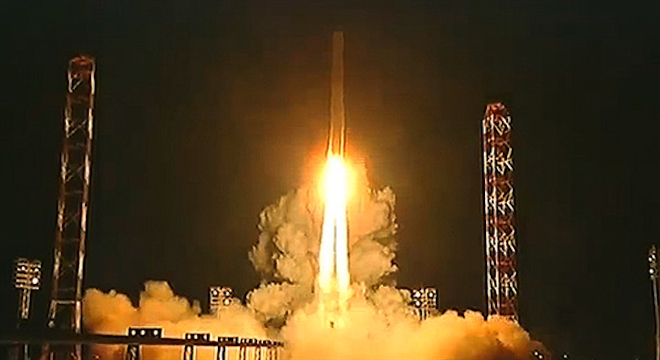Updated 11:17 am ET, Wednesday Nov. 23
Finally! The European Space Agency has made contact with Russia’s wayward Mars probe Phobos-Grunt, Russian news outlet Itar-Tass reported early Wednesday.
“We succeeded in creating relationship [sic] with the spacecraft. But till now there [has] been no information,” ESA Moscow chief Rene Pischel said, Itar-Tass reported.
“At present, we are working further with our Russian colleagues in order to decide what will do farther.”
“Unfortunately, we have no telemetric data,” said Vitaly Davydov, deputy head of the Russian Space Agency, “We simply do not understand what is going on there.”
ESA will now attempt to obtain systems data from the spacecraft, at which point it may be able to issue commands to push it safely into higher orbit, where it will become a piece of space junk, instead of crashing to Earth, which it otherwise is set to do at any point between late December and early February, according to the Associated Press.
There appears to be no hope of salvaging the original mission to get to Martian moon Phobos.
But if ESA and the Russian Space Agency fail to get the craft out of its current orbit, it’s headed for an uncontrolled descent, much in the manner of NASA’s UARS satellite and Germany’s ROSAT satellite, which both crashed harmlessly earlier in September and October.
Only the stakes are much higher for the Phobos-Grunt, as it is carrying nearly 16,000 lbs, the majority of its weight, in highly toxic rocket fuel that could explode or freeze and spill upon impact.
“If there is an explosion – that’s one thing,” Davydov told Itar Tass earlier, “If the probe just splits up, without an explosion, then it will be quite different,” he said.
Preliminary guesses from the Russian Space Agency indicate that the craft could rain debris over the Himalayas, but the agency won’t know more precisely until a day before impact.
Phobos Grunt suffered an engine-firing error error shortly after launch on November 8 that left the $163 million spacecraft stuck in an ultra-low Earth orbit, with scientists unable to communicate with it, much less attempt to direct the craft into a high-enough orbit to prevent it from eventually being dragged back to Earth in an uncontrolled free-fall.
The spacecraft was intended to travel to Mars and retrieve a soil sample from the surface of Phobots and return with it to Earth for analysis.
There was a lot riding on the mission, as Russia has suffered 18 failures in its attempts to send a craft to Mars over the past 50 years.
Additionally, the craft was carrying a German-Chinese Martian satellite, the Yinghuo-1, which would have been those two countries’ first foray to the Red Planet.
With the failure of Phobos Grunt, Russia has now turned its eyes toward a much closer, more familiar target: The Moon. Russia is reportedly at work on a nuclear-powered spacecraft that could take humans to both the Moon and, eventually Mars, according to Russian newspaper Ria Novosti.
“We have already said that we are planning to make the Moon our next step,” said Davydov, Ria Novosti reported. “It would be reasonable to focus on the Moon.”
First update: ESA’s satellite tracking station in Perth, Australia will make five separate attempts to receive the necessary telemetry data from the Phobos Grunt on Thursday, Ria Novosti reports.
“We will make five attempts to get the telemetry data from Russia’s Phobos-Grunt spacecraft,” ESA spokesman Rene Pischel said. “Each attempt will continue for 6-7 minutes.”









